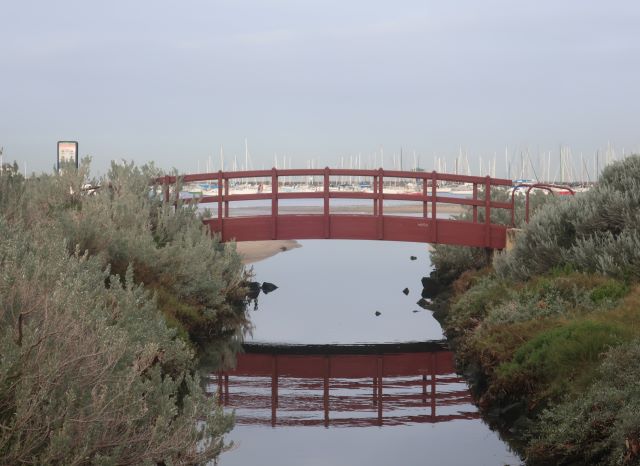
Drain or wetland in Port Melbourne?
A wetland after the storm
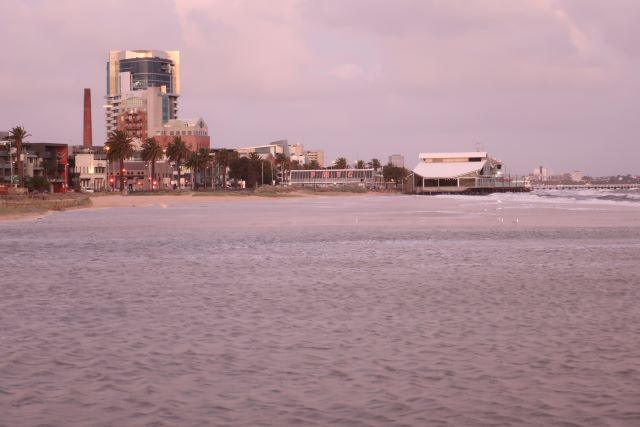
When a high tide and heavy rain coincide, the beach between the Port Melbourne Yacht Club and the TT Lines truck park becomes a temporary wetland which slowly recedes into a feather lined and rather smelly pool attracting silver gulls and dogs. Terns and Pacific gulls have also been seen when the wetland is fresh.
The beach is accreting1 here. Prevailing winds and the barrier of the TT Lines carpark cause sand to be trapped. The beach is growing deeper and wider. The growing beach has left the drain outlet high and dry up the beach and half filled with sand.
At one time, a timber jetty covered the drain as illustrated in this photograph from the Port Melbourne Historical Society’s collection.
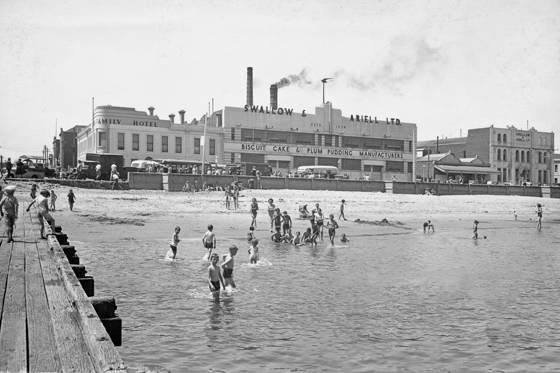
Photo Port Melbourne Historical and Preservation Society
The Princes St drain is a Melbourne Water, rather than a Port Phillip Council, drain. Council is responsible for providing and maintaining local drains and managing any stormwater flooding from its drainage system while Melbourne Water is responsible for providing and maintaining main drains. Melbourne Water describes the drainage system this way:
‘When it rains, some water naturally seeps into the ground. To prevent the rest of it from flowing towards low-lying land, the drainage system directs it into the bay.
- Stormwater enters house gutters and downpipes, and flows into residential drains
- Residential drains connect to council drains along streets and roads
- Council drains connect to Melbourne Water’s regional drains
- Regional drains direct stormwater into the bay via piped beach outlets’
The Princes St drain issue has been a concern for many years but not nearly as many as the arguments over resolving the ‘Lagoon Question’ which preoccupied decision makers in Port Melbourne in the late 19th Century.
The solution put forward by many, a long discharge pipe running alongside the TT Lines carpark and into Port Phillip Bay, has not progressed, partly because of the massive cost and competing priorities at Melbourne Water. A pipe would also do nothing to treat the stormwater before it enters the Bay.
Might an alternative approach lie within the City of Port Phillip?
After the construction of the breakwater at St Kilda for the 1956 Olympics, sand began accumulating at West Beach. By the early 1990s a weedy wetland wasteland beach of almost 7 acres had been created. The Cowderoy St drain also made its polluted way alongside Pier St onto the beach. Local naturalist and member of the City of St Kilda’s very first environment committee, Meyer Eidelson, saw the opportunity, rather than the problem in this weed infested land, as did Neil Blake, then a ranger with the City of St Kilda. A vegetation survey was undertaken and various valued salt marsh and coastal plants were identified. The idea of a rehabilitated beach park was welcomed by then Mayor of St Kilda, Melanie Eagle, and with the encouragement of Councillors and staff alike, it was agreed that the area would be rehabilitated into what has become the West Beach.
Neil and Zoe Hogg, champion advocate for the penguins on the breakwater, planted Disphyma crassifolium (rounded noonflower) and Atriplex cinerea (coastal salt bush) and various other salt loving plants along the Cowderoy St drain. Phragmites australis (common reed) from Moonee Ponds Creek was planted along the southern edge. Over time, with regular working bees by Earthcare St Kilda, taking out the noxious weeds, like the very prickly Juncus acutus, and planting in other reed and sedges species such as Ficinia nodosa has created a beautiful coastal refuge.
Today the charming bridge over the Cowderoy St drain outlet frames the view of the St Kilda Harbour. A recycled plastic boardwalk loops around West Beach in a very satisfying way, and benches are well positioned to catch the views.
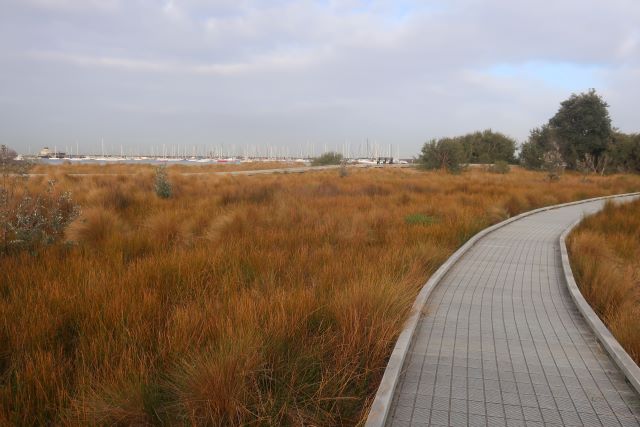
I caught up with Neil Blake, now Port Phillip Baykeeper, at West Beach before lockdown #5. He seemed satisfied with what had been achieved over thirty years. He noted the positive partnership between community and Council from the inception of the project. Overall, to him, the importance of the West Beach project lies in affirming the value of solutions that work with nature, rather than against it. With sea level rise and the accelerated erosion of beaches, the importance of creating and sustaining such landscapes has never been more important.
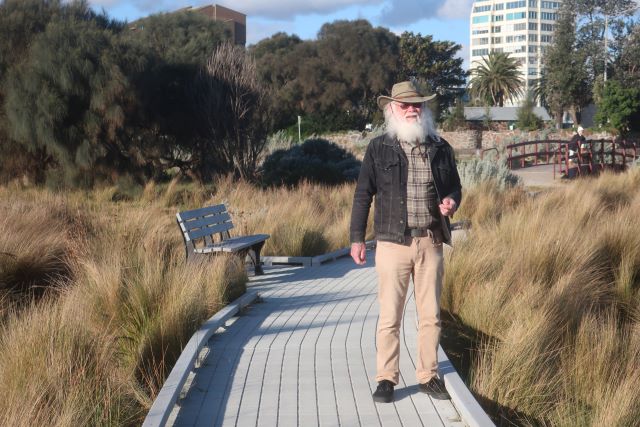
West Beach was the overall winner of the Keep Australia Beautiful National Clean Beach Award in 2016. The City of Port Phillip now describes 1.2 ha West Beach as being of very high, local, ecological significance. Of the sixty-six species, thirty-one are indigenous. Five regionally significant plant species are present: Carex pumila (Strand Sedge), Distichlis distichophylla (Australian Salt-grass), Spinifex sericeus (Hairy Spinifex), Sporobolus virginicus (Salt Couch), Suaeda australis (Austral seablite).
1accrete: grow by accumulation or coalescence
4 Comments
-
David John
Thank you Janet for a very interesting item. Like so many others we drive through Port Melbourne without a thought of what goes on behind the scenes. Please continue writing your articles that make Port Melbourne such an interesting place to visit or for others to live in.
-
Stephen Pennells
Wetlands yes, all sorts of creations! Whale Dreaming 2011 "at The cutting- Killarney, South West Victoria." https://photos.app.goo.gl/yg9J4PJzeLWpFNtM8


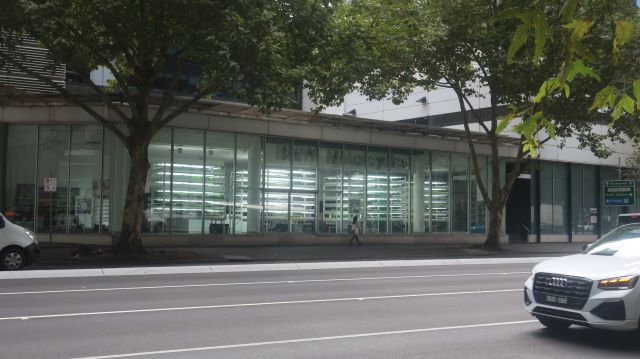
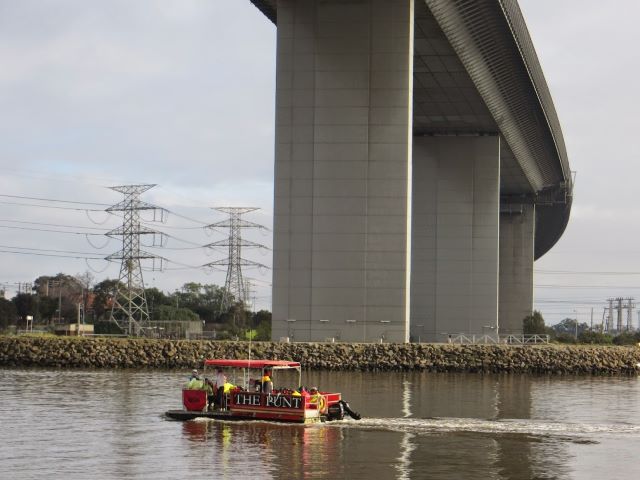
Reg Macey
An excellent proposal, Janet. I so hope that your suggestion is adopted.